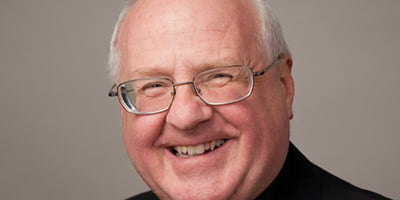
Father Mark Goldasich is the pastor of Sacred Heart parish in Tonganoxie. he has been editor of the Leaven since 1989.
by Father Mark Goldasich
Last Saturday night, I watched scores of people trip the light fantastic. Although very tempted to join them, I didn’t, as I was fearful I’d only do a fantastic trip into the lights.
Trip the light fantastic. Its first mention dates back to the English poet John Milton. The word “trip,” at least since the poet Geoffrey Chaucer used it in 1386, meant, “dance nimbly.” In Milton’s poem, “L’Allegro” (1645), he writes: “Come, and trip it as you go/On the light fantastic toe.” Over time, the word “toe” was forgotten, and we have the expression as it is today.
Those people I saw dancing were at a wedding reception of a longtime friend of mine. The bride and I had once played, danced and sung with the St. John’s Catholic Club Tamburitzans, a folk orchestra that sought to preserve the music of our Croatian ancestors who settled on Strawberry Hill in Kansas City, Kan. Not surprisingly, there was a tamburitza — that’s the generic name for the stringed instruments that are played — band from Chicago cranking out the tunes at the reception, and people made good use of the dance floor, especially to do kolos, or circle dances.
Another band — this one a zydeco, Bourbon Street, rock ‘n’ roll group, in which the bride is a vocalist and percussionist — played as well. Between the two, that dance floor got a workout. It was amazing to see how music could unite the diverse crowd: young and old; those attired in everything from business casual to shorts and Hawaiian shirts; and people from Kansas, Missouri, Nebraska, Illinois and Alaska.
I was still pondering this on Monday when I received an email with a video attached. The friend who sent it wrote: “I thought I’d share it because it just made me happy to watch people who weren’t arguing or fighting about anything. Makes one think that if we got rid of all the politicians and statesmen, we might actually have a lot in common.”
Well, I played the video . . . and then watched it a second time, then a third. And my friend was right: It made me happy, too. The five-minute clip features a song performed by Alicia Lemke, entitled “Trip the Light.” And, yes, it does refer to what I’ve been talking about: dancing. (It’s on YouTube, by the way.)
The video follows a man by the name of Matt Harding as he travels around the world and invites people — lots and lots of them — to dance with him. He dances in all kinds of ethnic costumes, in all kinds of venues: from the highlands of Scotland to the deserts of Saudi Arabia to the underwater depths of the Great Barrier Reef! Heck, at one point he even dances with a seal.
It’s like a National Geographic magazine come to life. Harding hits familiar places like Rome, Athens, Cairo, Moscow, Barcelona, Beijing and Jerusalem. And he travels to many American cities. But he also goes to exotic locales like: Tallinn, Estonia; Poria, Papua New Guinea; Terelj, Mongolia; Al-Muzahmiyya, Saudi Arabia; Opuwo, Namibia; and Rangli Island, Maldives. He even dances in dangerous places where I never picture people dancing: Rafah, Gaza Strip; Kabul, Afghanistan; Medellin, Colombia; Erbil, Iraq; and Damascus, Syria.
In every locale, the story is the same: Dancing unites people and makes them smile. The folks that you see in this video — Harding, in particular — are not professional dancers; they’re simply people moving in unison and having a great deal of fun in the process.
Dancing is both humbling and exhilarating. It’s humbling because it takes a person out of his or her comfort zone to move in ways and at a tempo that are outside our normal routine. This often seems awkward and unnatural at first. In other words, we’re awfully selfconscious when we’re hoofing it.
At the same time, though, it’s exhilarating. As one song puts it, we “let the music take control” and enter, in a sense, into the harmony of all creation. The lyrics in the video speak about traveling “far from what I know/I’ll be swept away. . . . We’re gonna trip the light/We’re gonna break the night/And we’ll see with new eyes/When we trip the light.”
That’s what Harding experiences in his dance around the world. Essentially, people are people, no matter where they live. Dancing is one way to break the “night” of prejudice and fear that so often divides us. It gives us new eyes. Music and dance are a language that we can all understand.
I wonder what would happen if, for example, Congress or the United Nations started every session by dancing. Would humility replace arrogance? Would laughter be heard instead of shouting? Would we move together in a common direction rather than pull apart?
I guess that all we can do for now is dream of that and entrust ourselves and our world to the Lord of the Dance

